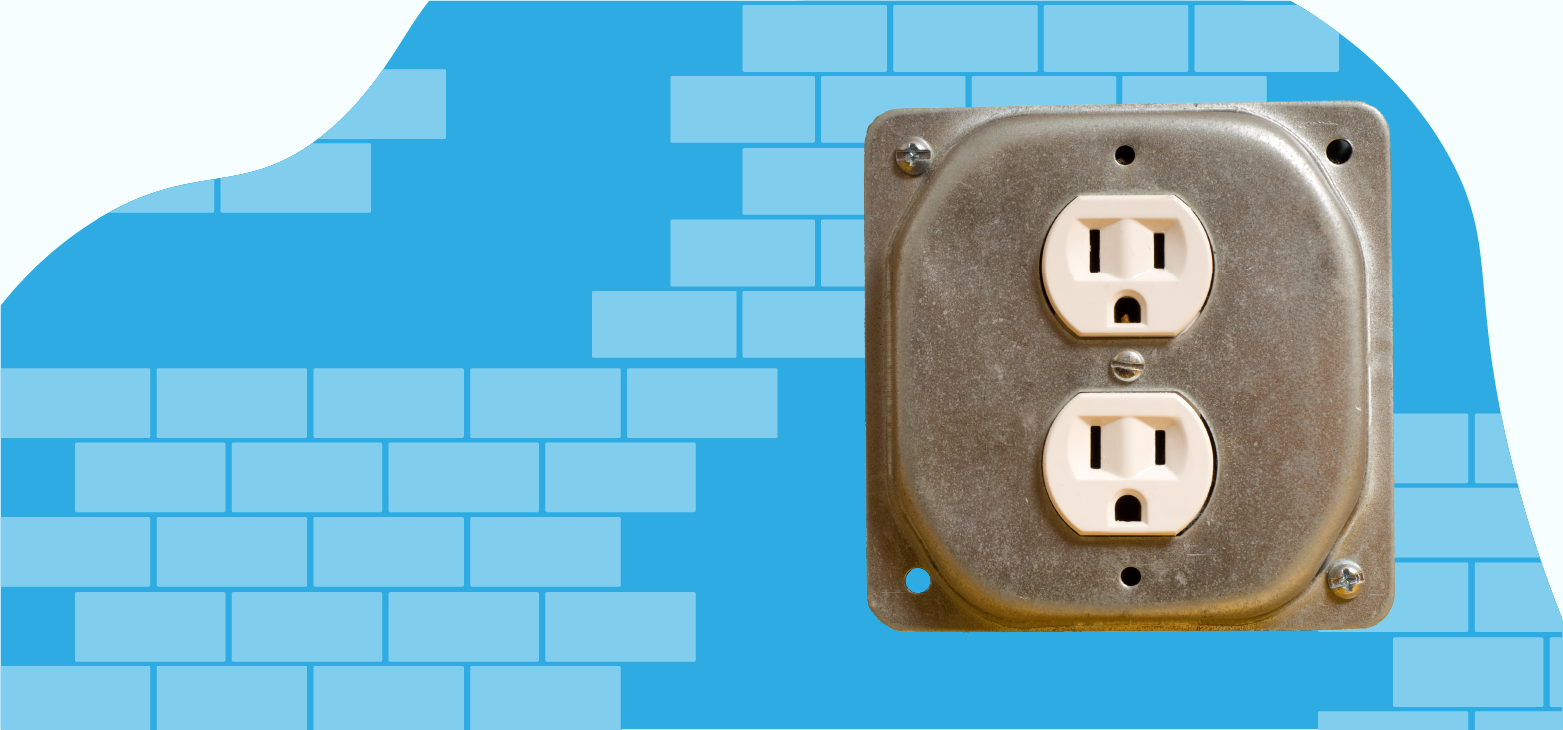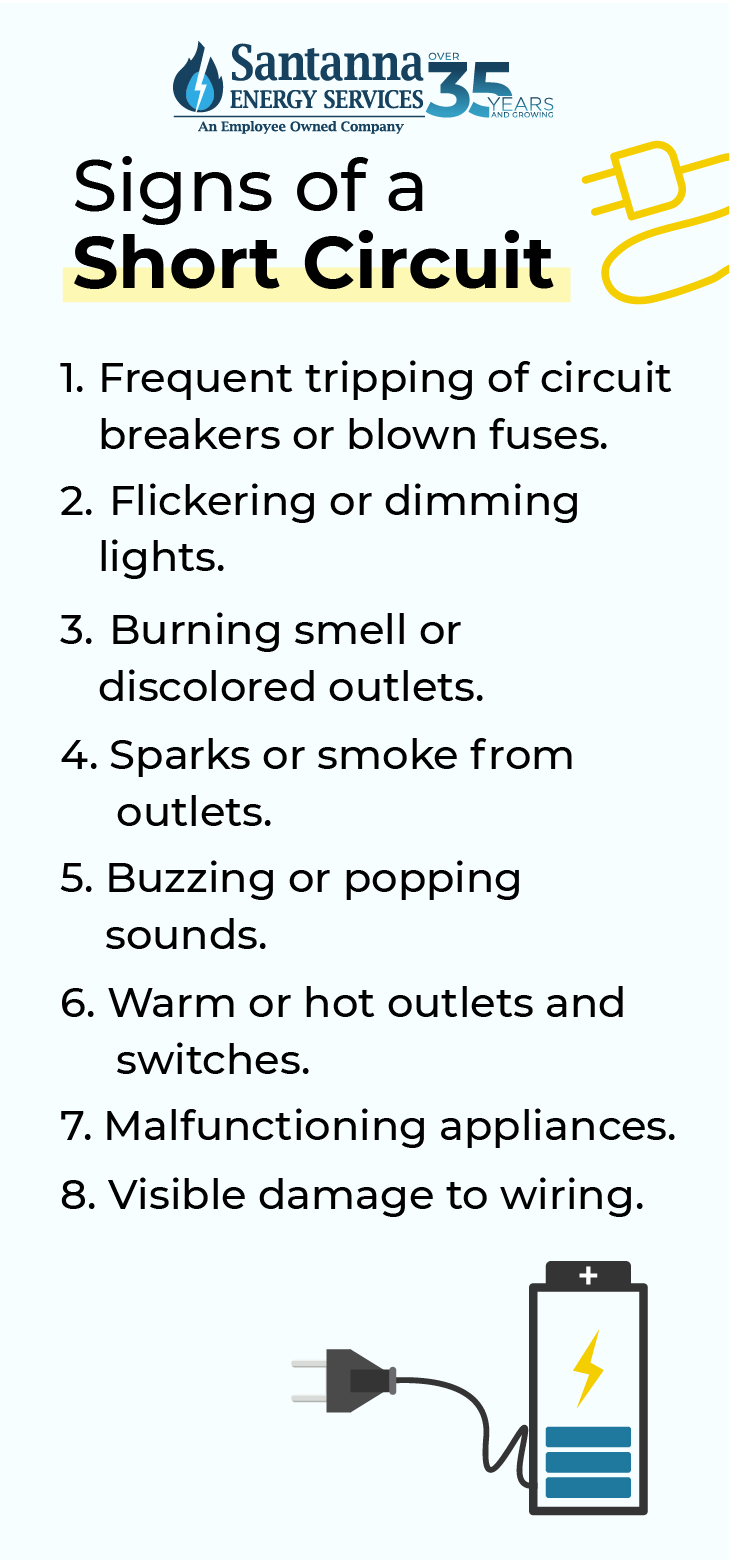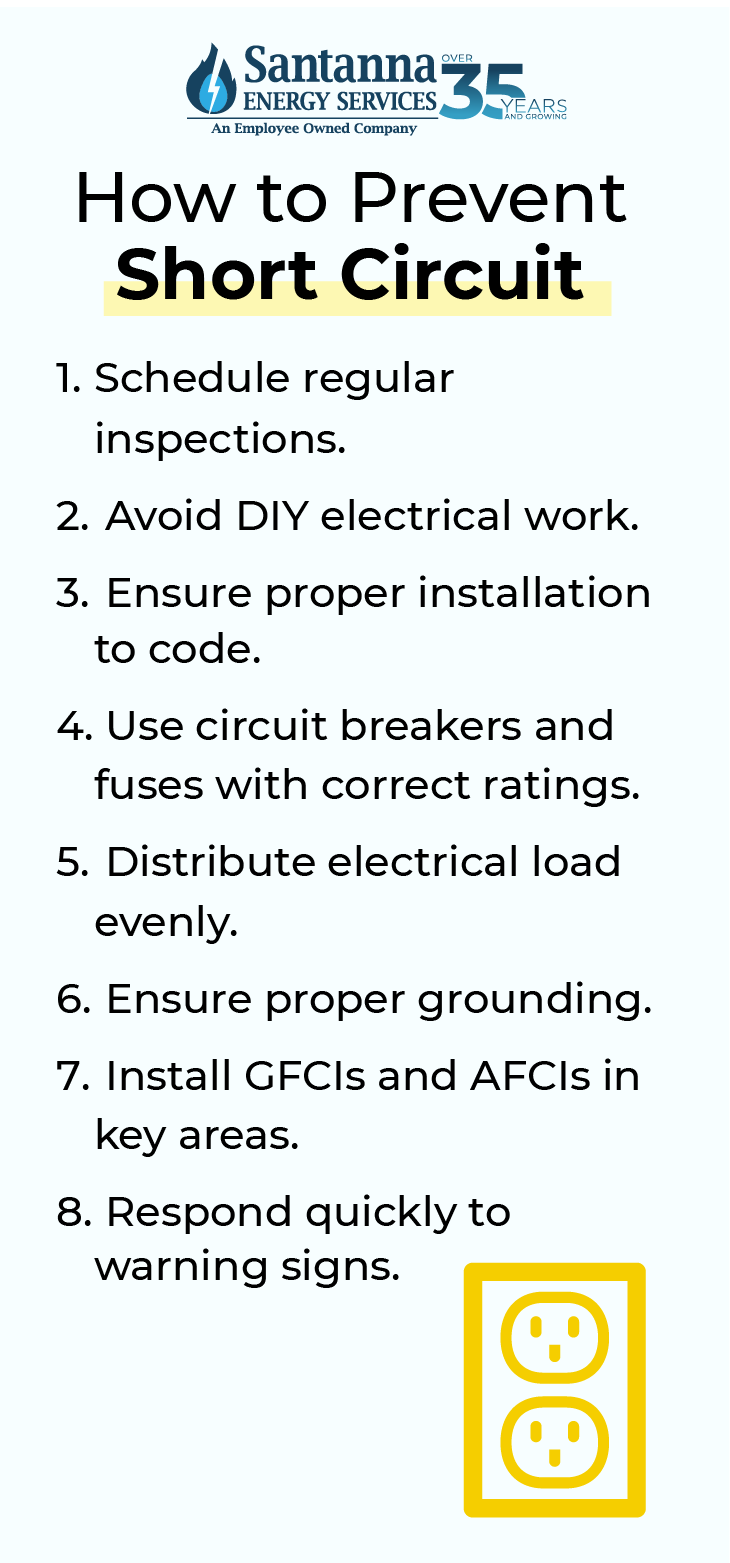What is a Short Circuit?
by Tyler Castle
20 min read

It usually starts with something small. A faint burning smell. A flickering light. A sudden pop behind the wall. Most people shrug it off, until something bigger happens. Electrical issues have a way of hiding in plain sight, often dismissed until they become too serious to ignore. But behind those subtle signs could be a problem capable of damaging your appliances, disrupting your home, or even starting a fire.
That’s why understanding what’s going on beneath the surface is more than just a smart move—it’s a necessary one. Whether you’ve experienced something unusual or you just want to be prepared, gaining clarity on short circuits can make all the difference. Let’s break it down.
What Is a Short Circuit?
A short circuit occurs when electrical current deviates from its intended path and flows through an unintended, low-resistance route. This unintended path allows a surge of current to flow unchecked, which can lead to overheating, damage to electrical components, or even fires.
Think of your electrical system like a road. Normally, electricity follows a planned route, it leaves the power source, travels through your devices (like a lamp or appliance), and then loops back to where it started. This path is designed with just the right amount of resistance to keep everything running smoothly.
But sometimes, something goes wrong.
A short circuit is like electricity finding a shortcut, one it’s not supposed to take. Instead of traveling through the device, the electricity suddenly zips through an unintended path that has little or no resistance. Because there’s nothing slowing it down, a surge of current rushes through.
This spike in current can cause wires to overheat, parts to melt, and in worst cases, even start a fire. Luckily, your home’s circuit breakers or fuses are there to stop the flow when this happens. But even then, the damage may already be done, especially to the devices that got caught in the surge.
The opposite of a short circuit is an open circuit, where there’s too much resistance—or essentially a break in the circuit—so electricity can’t flow at all. It’s like flipping a switch off or cutting a wire: the connection is broken, and the current has nowhere to go.
How Do You Find a Short Circuit in Your House?
In a properly functioning electrical circuit, current flows from the power source through conductors to a load (like a light bulb or appliance) and then returns to the source. This path includes components designed to control and utilize electrical energy safely.
However, if the insulation of wires is damaged or if conductors come into unintended contact—such as a hot wire touching a neutral wire—the current bypasses the designed load. This creates a direct path with little to no resistance, resulting in a sudden and excessive flow of electricity.
To find a short circuit:
- Start by looking for obvious signs, like tripped breakers, blown fuses, or scorch marks around outlets. Those signs can be clear indicators of where your short circuited wire is located.
- If you suspect a short, turn off the power to the circuit in your breaker box. Just as a safety, we recommend turning off your electricity completely for a minutes in case you tamper with the wrong wire.
- Next, use a multimeter to check for continuity between the hot and neutral wires. If there’s continuity when the circuit should be open, a short is likely present. You can also isolate the issue by disconnecting devices one at a time and seeing when the breaker stops tripping.
When it comes to locating a short circuit specifically in your home, the process becomes more targeted. Begin by:
- Identifying which circuit breaker keeps tripping—that tells you where the problem might be.
- Unplug everything connected to that circuit, reset the breaker, and start plugging in devices one by one to test the circuit.
- If the breaker trips again, the last thing you plugged in might be faulty. But if the issue persists even when nothing is plugged in, the problem could be in the wiring or outlets themselves.
- At this point, inspecting outlet covers, switch plates, and visible wiring for burn marks or odors can help.
For anything beyond a quick fix, it’s safest to call a licensed electrician to avoid the risk of electrical shock or fire.
How Does a Short Circuit Occur?
A short circuit occurs when something disrupts that loop of electricity to the circuit. This often occurs when wires that shouldn’t touch—like a hot (live) wire and a neutral or ground wire—accidentally make contact. That contact creates a low-resistance path, which means there’s nothing slowing down the flow of electricity.
Because there’s no resistance in the way, a massive surge of current rushes through, which can quickly overheat wires, melt insulation, damage electronics, or start a fire. This can lead to:
- Overheating: The excessive current can generate significant heat, potentially causing wires to melt and ignite surrounding materials.
- Damage to Components: Sensitive electronic parts can be destroyed by the sudden surge of current.
- Fire Hazards: The heat and sparks from a short circuit can ignite fires, posing risks to property and life.
- Electrical Shocks: Exposed conductive parts due to a short circuit can lead to electric shocks upon contact.
Types of Short Circuits
There are two common types of short circuits that can occur in an electrical system, and both can be serious if not addressed quickly.
Simple Short Circuit
This is the kind most people are familiar with. It happens when a “hot” wire—one carrying electricity—accidentally touches another wire, usually a neutral one. When that happens, electricity takes a shortcut with very little resistance. That sudden surge of current can overheat the wires, create sparks, or in worst cases, start a fire. It’s one of the most frequent electrical issues and shouldn’t be ignored.
Ground Fault Short Circuit
A ground fault happens when the hot wire touches something that’s grounded, like a metal electrical box or a bare wire. Instead of following its normal path, the electricity shoots straight into the ground. That’s a big problem because it can trip your breaker, damage sensitive electronics, and even create a shock hazard if someone is nearby. Ground faults are especially important to catch early, both for your safety and your home’s electrical system.
What Causes Short Circuits?
Short circuits are one of the leading causes of electrical fires and equipment damage. Understanding their causes is crucial for prevention. Here are common causes of short circuits in your home:
1. Rodents Chewing on Wires
Rodents like mice and squirrels often chew on electrical wires, exposing the metal conductors. This can lead to unintended contact between wires or with conductive surfaces, causing short circuits and potential fires. Be sure to protect your wires by using cord protectors or duct tape over the cord you want to protect.
2. Water or Moisture Exposure
Water is a conductor of electricity. When electrical wiring comes into contact with water due to leaks, flooding, or condensation, it can create a path for electricity to flow improperly. This broken flow can lead to short circuits and even electrical shock.
3. Loose Electrical Connections
Loose connections in outlets, switches, or junction boxes can cause intermittent contact between wires. This may lead to arcing, where electricity jumps across small gaps between conductors. Arcing generates intense heat, which can melt insulation, damage wiring, and even ignite surrounding materials—significantly increasing the risk of electrical fires.
4. Aging or Damaged Electrical Components
Electrical components naturally deteriorate over time due to wear, environmental exposure, and regular use. Cracked outlets, brittle insulation, or corroded terminals can expose live wires or cause unintended contact between conductors. These conditions can allow electricity to bypass its proper path, triggering a short circuit or fire hazard.
5. Nails or Screws Piercing Wires
Driving nails or screws into walls without checking for hidden wires can puncture wires. This physical damage can connect the hot and neutral wires (or ground), creating a direct and dangerous path for electrical current—resulting in an immediate short circuit.
6. Worn or Damaged Wire Insulation
The insulation that wraps around electrical wires is essential for preventing conductors from touching each other or nearby surfaces. Over time, exposure to heat, UV light, rodents, or physical abrasion can wear down this protective layer. Once insulation fails, wires can make unintended contact, creating a short circuit and increasing fire risk.
7. Power Surges or Electrical Overloads
Using too many high-wattage devices on one circuit or outlet can cause an overload, straining the electrical system beyond its designed capacity. Similarly, power surges—often caused by lightning or grid fluctuations—can damage insulation or components. These events may force electricity into unintended pathways, leading to short circuits or damaged equipment.
8. Faulty Wiring
Wiring that was installed incorrectly, undersized for the load, or damaged during renovations can easily become a hazard. Loose connections, reversed polarity, or improper grounding can create abnormal current flow and increase the likelihood of a short circuit. Poor workmanship or non-code installations often contribute to this issue.
9. Equipment Failure
Malfunctioning appliances or devices can have internal faults that cause short circuits, posing risks to both the equipment and the electrical system. Internal shorts within the device can send excess current back into the home’s wiring, potentially tripping breakers, damaging outlets, or creating fire hazards.
Signs of a Short Circuit
Recognizing the early signs of a short circuit is crucial for preventing potential hazards such as electrical fires, equipment damage, or personal injury. Here are some common indicators that may suggest a short circuit in your electrical system:
- Frequent Tripping of Circuit Breakers or Blown Fuses: If your circuit breakers trip or fuses blow repeatedly, it could indicate a short circuit. This happens because the electrical current exceeds safe levels, triggering protective devices to shut off the power.
- Flickering or Dimming Lights: Lights that flicker or dim unexpectedly may be a sign of a short circuit. This occurs when the electrical current is interrupted or diverted due to faulty wiring or connections.
- Burning Smell or Discolored Outlets: A noticeable burning odor or discoloration around outlets and switches can indicate overheating caused by a short circuit. This is often due to wires overheating and melting their insulation.
- Sparks or Smoke from Outlets: Seeing sparks or smoke emanating from outlets or appliances is a serious warning sign of a short circuit. This suggests that electrical arcing is occurring, which can lead to fires if not addressed promptly.
- Buzzing or Popping Sounds: Unusual sounds like buzzing or popping near electrical outlets or switches may indicate a short circuit. These noises result from electrical arcing or rapid current fluctuations.
- Warm or Hot Outlets and Switches: If outlets or switches feel warm or hot to the touch, it could be due to a short circuit causing excessive current flow and heat buildup.
- Malfunctioning Appliances: Appliances that suddenly stop working or operate erratically may be experiencing internal short circuits. This can be due to damaged wiring or components within the device.
- Visible Damage to Wiring: Inspecting your wiring for visible signs of damage, such as frayed insulation or exposed wires, can help identify potential short circuits before they cause more significant issues.

Why Short Circuits Are Dangerous?
Short circuits are more than just electrical mishaps as they pose significant risks to property, equipment, and personal safety. Here’s a breakdown of why they are dangerous:
Short Circuits Can Cause Overheating and Fire Hazards
When a short circuit occurs, electrical current bypasses the intended path and flows through an unintended, low-resistance route. This sudden surge in current generates excessive heat, which can cause wires to overheat and melt their insulation.
If this heat comes into contact with flammable materials, it can ignite fires. According to the National Fire Protection Association (NFPA), electrical malfunctions—including short circuits—are a leading cause of home fires, accounting for nearly 34,000 incidents per year on average, approximately 440 deaths and $1.3 billion in direct property damage annually.
You Risk Damage to Electrical Components
The excessive current from a short circuit can damage or destroy electrical components and appliances. Delicate parts like circuit boards, resistors, and capacitors are particularly vulnerable. Once damaged, these components often require replacement, leading to costly repairs.
Short Circuits Pose a Risk of Electrocution
Short circuits can expose live wires or create conductive paths through unintended materials. If a person comes into contact with these, they may receive an electric shock, which can lead to serious injuries or can even be fatal. The danger is heightened in wet or damp environments where the human body’s resistance is lower like bathrooms, garages, or outdoors.
Short Circuits Hold the Potential for Explosions in the Home
While explosions from short circuits are more common in industrial environments, they can still happen at home, especially in places where flammable materials are stored.
For example, if a short circuit occurs near a gas line, propane tank, paint thinner, or aerosol cans in your garage or basement, the resulting spark could ignite those fumes. That ignition can trigger a dangerous explosion or fire, putting both your property and your family at serious risk.
Shorts Can Cause System Downtime and Operational Disruptions
Beyond physical damage, short circuits can lead to system failures and operational halts. If a short circuit occurs on an important home device like a refrigerator, air conditioner or space heater, this can lead to discomfort and unexpected home hurdles. In commercial or industrial environments, this downtime can result in significant financial losses and affect productivity.
Where Could a Short Circuit Cause a Fire?
As we’ve said before, short circuits do have the potential to cause fires. And knowing where they most occur can save you from a lot of headaches or heartbreak later. These incidents can occur in various areas of a residence, posing significant risks to property and personal safety. Here are the common areas where short circuits can cause fires:
- Bedrooms: Bedrooms are frequently reported as the origin of residential electrical fires. This is often due to the use of extension cords, space heaters, or overloaded outlets near flammable materials like bedding and curtains. Be sure to keep an eye on what you plug in and check the functionality of your outlets to ensure they’re working properly.
- Attics and Crawl Spaces: These areas often contain electrical wiring that may be old or improperly installed. Rodents can chew through insulation, and the accumulation of dust can exacerbate fire risks.
- Living Rooms and Dens: High usage of electronic devices and entertainment systems can lead to overloaded circuits leading to short circuits and potentially fires. Faulty wiring behind walls or furniture can also go unnoticed until a fire starts. Even more so, like bedrooms, if faulty wires in your living room are near curtains or flammable materials, this can spark fires as well.
- Kitchens: The kitchen is a high-risk area due to the heavy use of appliances. Overloaded outlets, damaged cords, or faulty wiring in appliances can lead to short circuits and fires.
- Bathrooms: Despite being designed for moisture, bathrooms can still be susceptible to electrical fires. Water exposure to outlets or fixtures can cause short circuits, especially if GFCIs (Ground Fault Circuit Interrupters) are not installed. Open wires exposed to water can obviously risk the start of an electrical fire.
- Garages and Workshops: These areas often house power tools and equipment that draw significant power. Improper use of extension cords, outdated wiring, or exposure to flammable materials can increase the risk of short circuits and fire risks.
Are Short Circuits Useful?
Short circuits are not useful in most contexts. Short circuits are widely considered dangerous electrical faults.
In residential, commercial, and industrial settings, a short circuit indicates something has gone wrong in the system. Rather than serving a purpose, short circuits typically lead to damage, including overheating, fires, and equipment failure. While the term “short circuit” might sound neutral, its consequences are usually dangerous and unintentional.
For everyday purposes, short circuits are faults to avoid, not features to rely on. One of the only things involving short circuits that is useful is the circuit breaker “shut off” function in your breaker box when a short circuit occurs.
This function is put in place as a safety measure to automatically cut off the flow of electricity when a short circuit occurs, preventing overheating, electrical fires, and damage to your appliances or wiring.
How to Fix a Short Circuit
So, you’ve figured out there’s a short circuit in your home, what do you do about it? Fixing a short circuit in your home requires a careful and methodical approach to ensure safety and prevent further damage. Here’s a step-by-step guide on how to fix it:
- Turn Off Power: Immediately shut off the power at the main breaker panel to prevent electrical hazards. This also helps to ensure you don’t tamper with the wrong circuit and prevent further electrical damage.
- Identify the Problem Area: Note which breaker has tripped and which outlets or appliances are affected. This helps narrow down the location of the short circuit and figure out what you can do to fix it.
- Inspect for Visible Damage: To locate the affected outlet, look for signs of damage such as burnt outlets, frayed wires, or scorch marks on appliances. These are common indicators of a short circuit that can help you identify which outlet is affected.
- Test the Circuit: Once you’ve found which outlet is short circuited, use a multimeter to check for continuity and identify if a short exists between the hot and neutral wires. This step should only be performed if you’re experienced with electrical testing.
- Address the Issue: If the problem is with an appliance, unplug it and have it repaired or replaced. If the wiring is the issue, it’s advisable to contact a licensed electrician to repair or replace the faulty wiring.
- Restore Power: Once the issue has been resolved, or an action plan is put in place, restore power and monitor the circuit to ensure it operates correctly without tripping. If your problem requires an electrical professional, it’s best to turn off the breaker associated with the outlet until the problem is addressed to avoid further electrical trouble.
Note that attempting a DIY approach can be risky, and if you’re at all unsure or uncomfortable with the process, it’s safer and smarter to leave it to a licensed professional.
How to Prevent Short Circuits
Short circuits aren’t something to take lightly. This can lead to disasters at home and long-term headaches if you ignore the signs. That’s why it’s important to know the crucial steps for prevention. Here’s how to prevent short circuits in your home:
- Schedule Regular Inspections: Have a licensed electrician periodically check your wiring, outlets, and panels for signs of wear, overheating, corrosion, or damage.
- Avoid DIY Electrical Work: Improperly installed outlets, switches, or fixtures can lead to faulty connections and increased risk of short circuits. Always hire a qualified professional.
- Ensure Proper Installation to Code: Electrical systems should be installed in compliance with national and local building codes to ensure safe operation and proper circuit design.
- Use Circuit Breakers and Fuses with Correct Ratings: Make sure your home uses circuit breakers or fuses that match the electrical load they protect. Replace outdated fuse boxes with modern breaker panels if needed.
- Distribute Electrical Load Evenly: Avoid overloading a single outlet or circuit. Spread appliances and devices across multiple circuits to prevent overheating and system failure.
- Ensure Proper Grounding: A grounded electrical system provides a safe path for stray current to travel to the earth, reducing the risk of shocks or fires in the event of a fault.
- Install GFCIs and AFCIs in Key Areas: Install GFCIs (Ground Fault Circuit Interrupters) in areas where water is present like in bathrooms, kitchens, garages, and outdoor outlets. These special outlets shut off power if they detect moisture or a shock risk, helping prevent electrical accidents where water and electricity might mix. Also, use AFCIs (Arc Fault Circuit Interrupters) in bedrooms, living rooms, and older parts of the home. These devices are designed to catch hidden wiring problems that may cause sparks or fires. They monitor for unusual electrical patterns and shut things down before they become dangerous.
- Respond Quickly to Warning Signs: Flickering lights, burning smells, buzzing outlets, or frequently tripped breakers can all signal a potential short. Don’t ignore them—call a licensed electrician immediately.

When to Call a Professional
While some minor electrical tasks like resetting a breaker or unplugging an appliance might be safe to handle on your own, you should call a licensed electrician if:
- The circuit breaker keeps tripping repeatedly, even after you unplug devices.
- You notice burning smells, scorch marks, or buzzing sounds from outlets or switches.
- There are visible signs of damage to wires, outlets, or panels.
- You’ve tried basic troubleshooting, but power still won’t restore safely.
- You suspect the problem is inside the walls, in the breaker box, or with the wiring itself.
- You feel unsure or uncomfortable dealing with the issue.
Electricity is dangerous. Trying to fix a short circuit without proper tools or training can lead to electric shock, fire, or more costly damage. If in doubt, don’t guess—call a professional. A qualified electrician can safely inspect, diagnose, and fix the problem while keeping your home protected.
FAQs
Can Outdoor Electrical Boxes Also Experience Short Circuits?
Yes, outdoor electrical boxes can indeed experience short circuits, and they are particularly vulnerable due to their exposure to environmental elements.
Exposure to rain, snow, and high humidity can allow moisture to seep into these boxes, leading to corrosion and deterioration of wire insulation, conditions that make short circuits far more likely.
Why Does a Short Circuit Make a “Boom” Noise?
When a short circuit occurs, it often produces a sudden, loud “boom” or popping sound. This noise results from a rapid electrical event known as an arc flash. When an arc fault happens, it’s not just a spark—it’s a powerful electrical explosion.
Two things come out of that explosion: arc flash and arc blast. The arc flash is the blinding light and extreme heat you see and feel, while the arc blast is the shockwave that follows, kind of like a mini explosion of pressure. This creates a plasma arc that can reach temperatures of up to 35,000°F (19,400°C)—hotter than the surface of the sun. The intense heat causes the surrounding air to expand rapidly, producing a pressure wave that we perceive as a loud “boom”.
It is estimated that 5 to 10 arc fault incidents happen every single day in the U.S., according to the Bureau of Labor Statistics. That’s why anyone working around electricity needs to fully understand what they’re dealing with.
Short circuits might seem like sudden, unexpected problems—but with the right knowledge and a few simple habits, they’re often preventable. From spotting the warning signs to scheduling regular inspections, staying proactive is the best way to protect your home, your appliances, and your family’s safety.
And when it comes to powering your home, peace of mind shouldn’t stop at prevention. With Santanna’s Unlimited Energy electricity plan, you get predictability on your energy needs and your monthly bills—no matter the season or how much electricity you use.*
With Unlimited Energy electricity, enjoy a flat supply charge so you can stay comfortable without worrying about surprise spikes in the supply charge of your bill.* Explore the Unlimited Energy plan today and stay protected from more than just short circuits.
* Restrictions apply. Enrollment based upon program eligibility. Customers using more than 125% of normal monthly usage as determined by Santanna may be required to switch plans.
Tyler is an experienced energy professional, having worked for Santanna Energy Services, for the past four years. He is passionate about renewable energy and believes that diversifying the energy grid is the key to a sustainable future. Tyler is dedicated to supplying consumers with the best possible energy solutions and works diligently to make sure that Santanna can deliver the highest quality service.







